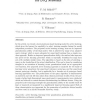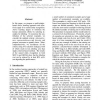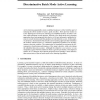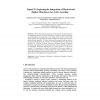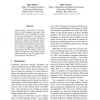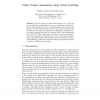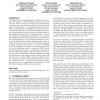ESANN
2006
14 years 2 months ago
2006
In this article, we extend a local prototype-based learning model by active learning, which gives the learner the capability to select training samples during the model adaptation...
ACL
2004
14 years 2 months ago
2004
In this paper, we propose a multi-criteriabased active learning approach and effectively apply it to named entity recognition. Active learning targets to minimize the human annota...
NIPS
2007
14 years 2 months ago
2007
Active learning sequentially selects unlabeled instances to label with the goal of reducing the effort needed to learn a good classifier. Most previous studies in active learning...
SDM
2008
SIAM
14 years 2 months ago
2008
SIAM
Optimally designing the location of training input points (active learning) and choosing the best model (model selection) are two important components of supervised learning and h...
NIPS
2008
14 years 2 months ago
2008
We investigate a topic at the interface of machine learning and cognitive science. Human active learning, where learners can actively query the world for information, is contraste...
INTERACT
2007
14 years 2 months ago
2007
Active Learning in the classroom domain presents an interesting case for integrating physical and digital affordances. Traditional physical handouts and transparencies are giving w...
EMNLP
2008
14 years 2 months ago
2008
Active learning is well-suited to many problems in natural language processing, where unlabeled data may be abundant but annotation is slow and expensive. This paper aims to shed ...
ECIR
2008
Springer
14 years 2 months ago
2008
Springer
Concept indexing in multimedia libraries is very useful for users searching and browsing but it is a very challenging research problem as well. Beyond the systems' implementat...
ECIR
2007
Springer
14 years 2 months ago
2007
Springer
Automated text categorisation systems learn a generalised hypothesis from large numbers of labelled examples. However, in many domains labelled data is scarce and expensive to obta...
DGO
2008
14 years 2 months ago
2008
We address the e-rulemaking problem of reducing the manual labor required to analyze public comment sets. In current and previous work, for example, text categorization techniques...
